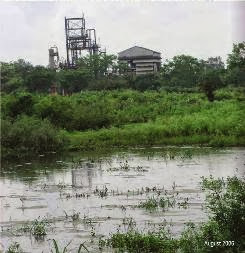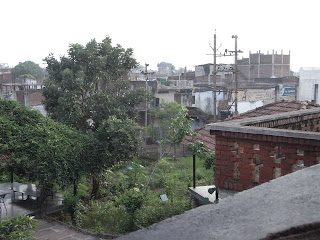But what I
reported on 3rd Sept post (The Night of the Explosion) was just the
beginning. Many of you reading this will not know about the pollution of the
groundwater, sometimes dubbed “Bhopal’s Second Disaster”.
For
years before 1984, the company was dumping toxic wastes around the factory site
in inadequate containers. In an
affidavit to the New York court in 1999, one worker said that, since 1969, quantities
of solvents, pesticides, by-products etc were dumped in and around the site.
Despite
warnings, the company built several large waste evaporation ponds as this
picture by Andy Spyra shows. There were warnings and rumours and mysterious
deaths of livestock; cattle died after drinking from the waste ponds. UCC
denied any responsibility but unease grew as any land onto which the ponds
overflowed had a drastic decline in fertility. Some years later, an increase in
births of damaged babies was noticed.
After
the incident the site was abandoned to the elements and more containers of
chemicals rusted or broke down spilling contents over the ground. With every
rainy season these chemicals have been washed through the soil into the
groundwater aquifers from where it has been pumped up for drinking, washing,
cooking etc, even for children to splash around in.
Even
though the local authority of Madhya Pradesh provides a limited number of
tankers of water it can be spasmodic and does not reach all the people with
affected water supplies. And a couple of years ago there was an ecoli scare
from even that water.
It
is estimated that over 100,000 people are chronically sick from the effects of
that night and in addition 30,000 are ill from polluted water, including second
and third generation children. Local campaigners estimate that about 500,000
people live in the area of northern Bhopal affected and that some 90+% are affected
to a greater or lesser extent.
So
what is in the water? Well, actually we don’t know with 100% accuracy, despite
many tests including mass spectrometry. In fact UCC and now Dow Chemical refuse
to disclose the information citing commercial confidence. They also will not
list the possible gasses and compounds that could have been created by chemical
reactions during the explosion
In
1989, UCC carried out some simple tests by taking samples of groundwater and
also adding soil samples to clean water. Fish were placed in the containers.
There was “100% mortality”, ie all the fish died! It was noted at the time that
both types of sample were heavily contaminated with both naphthol and
naphthalene*. Despite the dangers to health that both of these present, UCC did
not issue any health warnings, and, in fact denied it,
* Naphthol can lead to abdominal pain,
convulsions, diarrhoea and vomiting while naphthalene can cause anaemia,
cataracts, retinal damage, liver damage, brain damage and possibly cancer.
In
1989 tests were carried out. The State Pollution Control Board (PCB) requested
the National Environmental and Engineering Research Institute (NEERI) despite that
fact that it had almost no experience in this type of research. About the same
time UCIL decided to conduct studies and internal memos show it found large scale
contamination. UCIL offered to guide NEERI and in early 1990 the subsequent
report found no contamination! This greatly pleased UCC. We can only speculate
about the quality and accuracy of the published result.
However,
in 1990 a further study was conducted by the Bhopal State Research Laboratory
(BSRL), working with an independent USA laboratory, which found major
contamination in lake sediment with pthalates, i-napthalene, benzene, other
aromatic hydrocarbons and organochlorides including di- and tri-chlorobenzenes.
Which caused an angry response from UCC at their AGM and in writing, see http://www.bhopalmarathon.org/letter-of-may-16-1990-from-subimal-bose-to-babu-lal-gaur/
Despite these findings being more in line with their own internal report, a
fact not mentioned in the letter.
“During the monsoon, the areas receive rainfall, part of which moves out as surface run-off and the remaining percolates into the soil. The movement of the soil contaminates with surface run-off and water percolating under the surface is a matter of great concern in view of the environmental hazard potential associated with organic contaminants.”
So why the
differences? UCC’s own study took samples from within the walls of the factory
site. The NEERI and BSRL samples were taken from in and around the waste ‘lakes’,
some 400 metres away from the factory site. The BSRL samples included sediment
from the lakes, soil from around the lakes and samples from a well.







